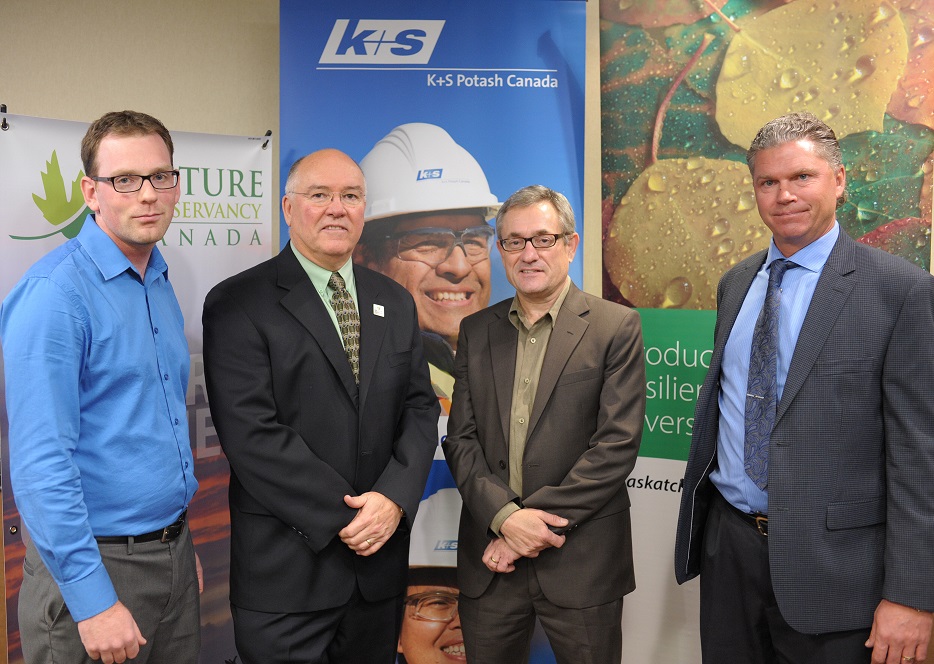Unprecedented Grassland Offset Project in Saskatchewan results from Multi-partner Collaboration
10-04-2016
Unprecedented Grassland Offset Project in Saskatchewan results from Multi-partner Collaboration
A new science-based method to calculate habitat offsets has resulted in the largest known industry investment in grassland habitat offset in Saskatchewan, valued at close to $1 million. The approach was developed through a collaboration between the Government of Saskatchewan, K+S Potash Canada (KSPC), and the Nature Conservancy of Canada (NCC) with the objective to achieve “no net loss” of native grasslands as a result of the construction of the KSPC’s Legacy Project near Bethune.
“Grasslands are one of the rarest and most at-risk biomes in the world, and are a critical part of Saskatchewan’s environment,” said Cameron Wood, Natural Area Manager for NCC. “They buffer our water and are a habitat with some of the world’s greatest biological diversity. Being able to protect them is one of the most important things we can do for the future. This new offset program is allowing us to turn necessary development into something extremely positive for nature conservation.”

In 2010, KSPC committed to offset natural grasslands affected by the development of their Legacy Project. But calculating an appropriate offset is not that simple. Governments and stakeholders have struggled to create fair compensation schemes that recognize that some habitats are more valuable than others and “like-for-like” or area-for-area doesn’t necessarily provide the best environmental outcome or use of resources. The formula-based approach tested at KSPC’s Legacy Project mine site estimates functional loss and required offsets using a system of “Debits and Credits.” The formula includes, among other things, the effect of development on species of concern and the effect of breaking up connected habitats.
“Science is the foundation of good environmental management,” says Erin Robertson, Environment Manager, KSPC. “This new approach considers the ecological value of habitats which is critical to ensure unavoidable impacts are offset appropriately.”
In the case of the Legacy Project mine site, this means that the 194 hectares of grasslands that have been impacted will be offset by conserving an estimated 402 hectares of high-value grassland. The plan enables NCC to invest in KSPC funding where it will provide the greatest conservation value possible.
“KSPC is pleased to be working with a credible organization like Nature Conservancy of Canada, which has the expertise to get the job done and ensure our commitment is met,” said Eric Cline, Vice President of Land and Sustainable Development.
Saskatchewan’s Ministry of Environment hopes that others will benefit from this approach as well and that it will be adopted by other stakeholders as a guide to minimize environmental footprints and conserve high-value habitats.
“This project shows how practical habitat mitigation approaches can help the industry achieve responsible development of natural resources while ensuring that important habitat is maintained in our province,” said Ministry of Environment’s Fish, Wildlife and Lands Executive Director, Brant Kirychuk. “We commend K+S Potash Canada and its partners for being an industry leader in this area. The lessons and feedback gained will help us further improve and develop this promising tool.
Your Contact People:
Tiffany Cassidy
Communications Manager
Nature Conservancy of Canada
Office: 306-347-0447 X222
Cell: 306-530-3161
tiffany.cassidy@natureconservancy.ca
Maeghan Dubois
Senior Communications Specialist
K+S Potash Canada GP
306-371-0122
maeghan.dubois@ks-potashcanada.com
Michele McEachern
Communications Consultant
Saskatchewan Ministry of Environment
306-787-0412
Michele.mceachern@gov.sk.ca